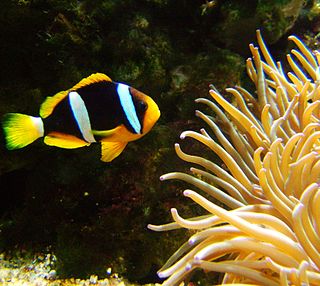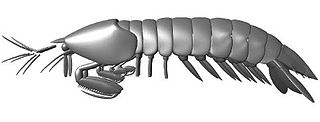
Mazon is a village in Mazon Township, Grundy County, Illinois, United States. The name derives from the Potawatomi word for "nettles" (mzan). The population was 1,015 at the 2010 census. The center of population of Illinois is located in Mazon. Illinois' State Fossil, the unique and bizarre Tully Monster was first found in nearby Mazon Creek. Mazon was formerly served by the Santa Fe railway at the Mazon Depot. It was established in 1876.

Clownfish or anemonefish are fishes from the subfamily Amphiprioninae in the family Pomacentridae. Thirty species of clownfish are recognized: one in the genus Premnas, while the remaining are in the genus Amphiprion. In the wild, they all form symbiotic mutualisms with sea anemones. Depending on the species, anemonefish are overall yellow, orange, or a reddish or blackish color, and many show white bars or patches. The largest can reach a length of 17 cm, while the smallest barely achieve 7–8 cm.

Tullimonstrum, colloquially known as the Tully monster or sometimes Tully's monster, is an extinct genus of soft-bodied bilaterian animal that lived in shallow tropical coastal waters of muddy estuaries during the Pennsylvanian geological period, about 300 million years ago. A single species, T. gregarium, is known. Examples of Tullimonstrum have been found only in the Essex biota, a smaller section of the Mazon Creek fossil beds of Illinois, United States. Its classification has been the subject of controversy, and interpretations of the fossil have likened it to molluscs, arthropods, conodonts, worms, tunicates, and vertebrates. This creature had a mostly cigar shaped body, with a triangular tail fin, two long stalked eyes, and a proboscis tipped with a mouth-like appendage. Based on the fossils, it seems this creature was a nektonic carnivore that hunted in the ocean’s water column. When Tullimonstrum was alive, Illinois was a mixture of ecosystems like muddy estuaries, marine environments, and rivers and lakes. Fossils of other organisms like crustacean Belotelson, the cnidarian Essexella, and the elasmobranch fish Bandringa have been found alongside Tullimonstrum.

Clark's anemonefish, also known as the yellowtail clownfish, is a marine fish belonging to the family Pomacentridae, the clownfishes and damselfishes.
The Mazon Creek fossil beds are a conservation lagerstätte found near Morris, in Grundy County, Illinois. The fossils are preserved in ironstone concretions, formed approximately 309 million years ago in the mid-Pennsylvanian epoch of the Carboniferous period. These concretions frequently preserve both hard and soft tissues of animal and plant materials, as well as many soft-bodied organisms that do not normally fossilize. The quality, quantity and diversity of fossils in the area, known since the mid-nineteenth century, make the Mazon Creek lagerstätte important to paleontologists attempting to reconstruct the paleoecology of the sites. The locality was declared a National Historic Landmark in 1997.
The Mazon River or Mazon Creek, is a tributary of the Illinois River in the United States. The confluence is near Morris, Illinois.

The UW–Madison Geology Museum (UWGM) is a geology and paleontology museum housed in Weeks Hall, in the southwest part of the University of Wisconsin–Madison campus. The museum's main undertakings are exhibits, outreach to the public, and research. It has the second highest attendance of any museum at the University of Wisconsin–Madison, exceeded only by the Chazen Museum of Art. The museum charges no admission.

The Indiana State Museum is a museum located in downtown Indianapolis, Indiana, United States. The museum houses exhibits on the science, art, culture, and history of Indiana from prehistoric times to the present day.
Pohlsepia mazonensis is a species of fossil organism with unknown affinity. Although it was originally identified as an extinct cephalopod, later studies denied that interpretation. The species is known from a single exceptionally preserved fossil discovered in the late Carboniferous (Pennsylvanian) Francis Creek Shale of the Carbondale Formation, north-east Illinois, United States.

Protophasma is an extinct genus of Protorthopteran insect from the Carboniferous of Europe and North America.
The Kokoamu Greensand is a geological formation found in New Zealand. It is a fossil-bearing, late Oligocene, greensand rock unit of the eastern South Island, especially the Waitaki District of North Otago and the southern Canterbury region. The formation was named by geologist Maxwell Gage in the 1950s. In North Otago it underlies the thicker and harder Otekaike Limestone. The formation gets its green colour from the mineral glauconite which forms slowly on the ocean floor.

Paleontology in Illinois refers to paleontological research occurring within or conducted by people from the U.S. state of Illinois. Scientists have found that Illinois was covered by a sea during the Paleozoic Era. Over time this sea was inhabited by animals including brachiopods, clams, corals, crinoids, sea snails, sponges, and trilobites.

Essexella is an extinct genus of cnidarian known from Late Carboniferous fossils; it contains a single species, E. asherae. It is one of the most recurrent organisms in the Mazon Creek fossil beds of Illinois; in the Essex biota of Mazon Creek, it consists of 42% of all fossil finds. Essexella was originally described as a jellyfish, but was recently redescribed as a sea anemone. The scientists on the "anemone" side of the debate made a book as early as 2017, but it was ignored until the same authors made a proper scientific paper in 2023.
The Nanjemoy Formation is a geologic formation pertaining to both the Wilcox Group and the Pamunkey Group of the eastern United States, stretching across the states of Virginia, Maryland, and District of Columbia. The formation crops out east of the Appalachians and dates back to the Paleogene period. Specifically to the Ypresian stage of the Eocene epoch, about 55 to 50 Ma or Wasatchian in the NALMA classification, defined by the contemporaneous Wasatch Formation of the Pacific US coast.

Coquimbo Formation is a Miocene to Middle Pleistocene sedimentary formation located in Coquimbo Region in Norte Chico, Chile. The lowermost unit belongs to the lower Miocene, with the third-deepest unit dated at 11.9 ± 1.0 Ma. The uppermost unit of the formation is estimated at 1.2 Ma. In the area of Tongoy, the Coquimbo Formation was deposited in an ancient bay that was formed in a graben or half-graben, with a normal fault dipping east. Sea level changes during the Holocene have caused erosion to cut several marine terraces into the formation.

The Hiló Formation is a geological formation of the Altiplano Cundiboyacense, Eastern Ranges of the Colombian Andes. The predominantly shale formation dates to the Middle Cretaceous period; Late Albian to Early Cenomanian epochs and has a measured thickness at its type section of 470 metres (1,540 ft). The fossiliferous formation has provided a great abundance of ammonites and other marine species.
Carbotubulus is a genus of extinct worm belonging to the group Lobopodia and known from the Carboniferous Carbondale Formation of the Mazon Creek area in Illinois, US. A monotypic genus, it contains one species Carbotubulus waloszeki. It was discovered and described by Joachim T. Haug, Georg Mayer, Carolin Haug, and Derek E.G. Briggs in 2012. With an age of about 300 million years, it is the first long-legged lobopodian discovered after the period of Cambrian explosion.

Tyrannophontes is an extinct genus of mantis shrimp that lived during the late Carboniferous period in what is now the Mazon Creek fossil beds of Illinois. It is the only genus in the family Tyrannophontidae. The type species, T. theridion, was described in 1969 by Frederick Schram. A second, much larger species, T. gigantion, was also named by Schram in 2007. Another species, T. acanthocercus from the Bear Gulch Limestone of Montana, was formerly assigned to Tyrannophontes, but has now been moved to the genus Daidal.












